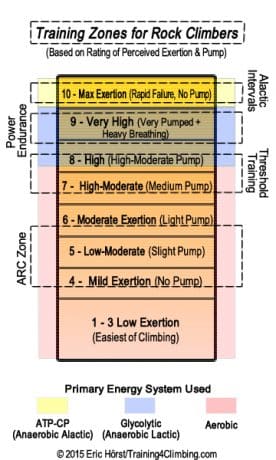Podcast: Energy System Training – Part 3
This is the third in a four-part series on energy system training as a conceptual model for organizing your workouts for improved training results and climbing performance. This episode is the conclusion of podcast #23 (on training the Anaerobic Lactic energy system) and it details specific training protocols for improving short, intermediate, and long power endurance. Combined, episodes #23 and #24 make for a super-sized (2+ hours!) brain-bursting, muscle-pumping training for climbing podcast!
Podcast Rundown
0:20 – Intro about how this podcast is actually the second half of Podcast #23—combined they make for 2 hours of instruction on energy system training. A super-sized podcast!
1:50 – The energy system focus remains how to best train up the anaerobic lactic energy system that “bridges” the ATP-CP and aerobic energy systems.
3:25 – A quick recap of the first part (episode #23) on how the anaerobic lactic system works…and the specific adaptations that we’re after.
8:00 – Important: How occlusion of forearm blood flow (during gripping of holds) accelerates intracellular acidification and hastens drop in power output. Thus, the importance of keeping blood flowing to “flush” metabolic byproducts and sustain some degree of aerobic power contribution.
9:25 – Rate of adaptation to training: Anaerobic lactic specific adaptations are relatively fast, whereas many aerobic system specific adaptations take months and years. A quick intro to the aerobic energy system adaptations that enable long-term training adaptations and improved endurance/capacity.
12:30 – A reminder of difference between “anaerobic power” and “anaerobic capacity”…and how you can test yourself for each.
21:00 – A quick disclosure on the variability, flaws, limitations, and validity of many current climbing tests of common performance indicators, such as finger flexor strength, lactic endurance, and aerobic power.
23:55 – Anaerobic capacity training (lactic system specific) protocols—I break into three categories: 1. “high-end” or “short” power endurance (peak power output for 15 to 30 seconds), 2. “intermediate power endurance” (sustained near-maximal power output for 40 to 60 seconds), and 3. “transitional” or “long power endurance” (1 to 3 minutes of moderately-high power climbing/exercise).
25:55 – The importance of the energy system “crossover” that occurs between 45 and 90 seconds, depending on the strength of your anaerobic lactic and aerobic energy systems. For most climbers, this anaerobic-aerobic crossover is likely between 60 and 75 seconds of sustained, high-intensity (no rest, no shake) climbing.
28:45 – How to train “high-end power endurance”. Brief all-out bursts of exercise/climbing with a work-to-rest ratio of at least 1:10. For example, 15 to 30 seconds of very hard exercise/climbing (9.5 to 10 out of 10 effort) followed by 3 to 5 minutes of rest.
33:26 – How to train “intermediate power endurance” for improved mid-range anaerobic capacity (up to one minute of sustained, no-rest, no-shake climbing). The goal is high-intensity exercise/climbing sustained for 40 to 60 seconds at a perceived exertion/intensity of 9 to 9.5 out of 10. This class of anaerobic training is commonly missing from climbers’ training programs—don’t let that be you!
41:50 – Train “long power endurance” (1 to 3 minute anaerobic capacity) with up to 3 minutes of sustained moderately high-intensity exercise or climbing. Perceived exertion should be 8.5 to 9 out of 10 with significant forearm muscle pump/pain and breathlessness. This is classic lactic “tolerance” training—it builds both mental and physical tolerance to the fatiguing byproducts of long-duration power climbing.
45:30 – A word of caution about training “long power endurance” too often or at too high a volume. Especially in-season, this type of training can lead to diminished performance among route climbers who climb outside for performance a few days per week. Overtraining syndrome warning: If you sense you’re getting weaker or losing power, despite immense training/climbing effort, this may be why.
52:35 – Final tips for applying this powerful information. Learn how to prioritize and schedule your training. And always remember that “the best training program for you is one you’re not doing!”
57:20 – Listen to this and the previous podcast several times—there’s a lot of powerful information to assimilate and learn to apply correctly.
58:05 – Please write a review of this podcast on iTunes…and SHARE with your friends!
58:40 – Visit TrainingForClimbing.com to sign-up for a monthly training newsletter and to get a FREE training-for-climbing eBOOK! Leave a question for the upcoming “Ask Coach Horst” podcast at my Twitter account @Train4Climbing
59:20 – Learn about the new ULTIMATE Hangboard…coming in early Summer 2018! Need a fingerboard for home training? Consider this one, which I designed for optimal finger flexor crimp and pocket training, both one- and two-arm training protocols. Learn more at TrainingForClimbing.com or Nicros.com
- Learn more about Energy System Training on TrainingForClimbing.com
- Purchase the latest edition of Training For Climbing–the world’s best-selling book on training for climbers.
Follow Eric on Twitter @Train4Climbing
Check out Eric’s YouTube channel.
Music by: Misty Murphy
Copyright © 2018 Eric J. Hörst | All Rights Reserved.


